The British army at the battle of Waterloo
At the Battle of Waterloo, the Duke of Wellington led the Allied forces to victory as the supreme commander. Made up of veterans from the Peninsular War who had fought the French in Spain, the British foot guards were among the most experienced troops. Known to refer to his men as the “scum of the earth”, Wellington was known to enforce strict discipline and would have no hesitation in having soldiers hanged if necessary. Before the battle, Wellington had visited the fields of Waterloo and famously declared his plans, saying “I kept it in my pocket”. The Allied forces were strategically positioned on the right flank at the farm of Hougoumont, surrounded by woods, with the Farm of La Haye Sainte in the centre and the farm of Papelotte on the left flank. This created a strong defensive position in anticipation of the arrival of Field Marshal Blucher and the Prussian army, who ultimately turned the tide at the most critical moment of the battle.

The British army commanders


The Duke of Wellington, commander in chief Allied army of the seventh coalition
Field Marshal Wellington was a military commander renowned for his leadership and strategic genius. He rose to prominence during the Napoleonic Wars, and was
commander of the Allied forces at the Battle of Waterloo. Wellington's tactics at the battle of Waterloo proved decisive, as his disciplined and experienced troops were
able to outmaneuver the French forces. He had a great understanding of the terrain, and a deep knowledge of the strengths and weaknesses of his army. He was also a
master of tactical retreats and feints, which allowed him to outwit the French forces. Wellington was also known for his courage under fire, often personally leading his troops into action. He was able to inspire his troops to feats of bravery, and his presence on the battlefield was often a decisive factor in the Allied victory. As such, Wellington played a major role in the Allied victory at the Battle of Waterloo, and his leadership and tactical genius will be remembered for generations to come.
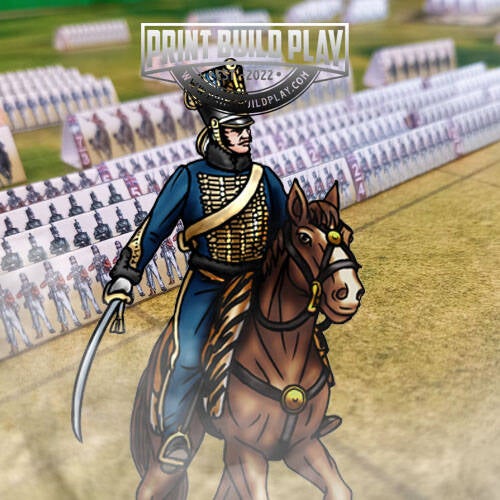
The Earl of Uxbridge, second in command
General Uxbridge was a highly respected military commander who served in the British army during the Battle of Waterloo in 1815. He was a brave soldier who
showed great leadership and strategic skill during the battle. Uxbridge was noted for leading a charge of British cavalry against the French forces during the battle. His
bravery and skill during the battle earned him the nickname 'The Hero of Waterloo'. Uxbridge was also credited with rallying his troops and providing them with
much needed morale during the battle. His strategies were so successful that it is said that he was instrumental in the eventual British victory. Uxbridge's contributions to
the Battle of Waterloo have earned him a place in history as one of the great military commanders of the Napoleonic Wars.

General Thomas Picton
General Picton was a military commander of the British forces in the battle of Waterloo. He was a veteran of the Napoleonic Wars, having been in service for more than 20 years. He was renowned for his bravery and tenacity in battle. At the Battle of Waterloo, General Picton commanded the 5th Infantry Division of the British army.
His division was tasked with defending the right flank of Wellington's forces. He led his men with great skill and courage, successfully holding the line against multiple
French attacks. He famously refused to retreat even when vastly outnumbered, and even when the odds seemed insurmountable he stood his ground and was killed in
combat. General Picton's actions in battle were instrumental in securing a British victory at Waterloo. His feats of bravery and leadership were highly praised by
Wellington and other British commanders. General Picton's legacy lives on in military history. His courage and valor have been an inspiration to many soldiers, serving
as a reminder of the power of courage and determination in the face of adversity. In Print Build Play's Waterloo, general Picton dies after 60 minutes in the game leaving the allies temporarily with 3 generals on the battlefield untill the arrival of the Prussians 1 hour later.
The infantry
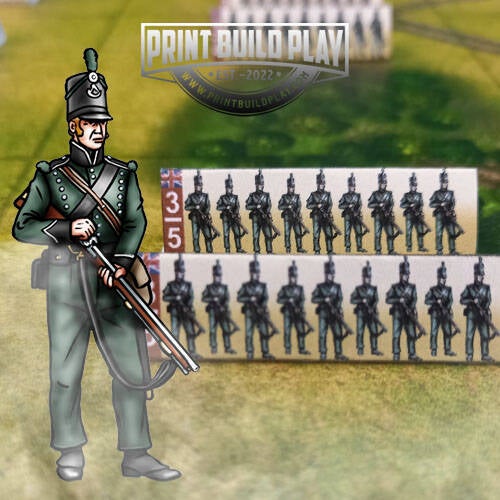
95th rifles
The 95th Rifles were an elite unit of the Napoleonic era military, renowned for their ability to fight on the battlefield. They were renowned for their marksmanship, often
out-shooting their enemies. They were also known for their mobility and the ability to fight in any terrain. In battle, the 95th Rifles would use their marksmanship to pick off
enemies from a distance, while their mobility allowed them to quickly move around the battlefield and flank enemies. The 95th Rifles would also use guerrilla tactics to outwit their opponents, such as ambushing them and using cover to hide their movements. Additionally, they had the advantage of having higher morale than their opponents, as they were often seen as the underdog. By combining these tactics, the 95th Rifles were able to fight effectively on the battlefield and gain the upper hand in battle.

71st Light infantry Glasgow Highlanders
The 71st Light Infantry Glasgow Highlanders were a Napoleonic era military unit that served in the British Army. Their primary role was to provide a mobile and agile
fighting force that could support an attack or defend against an enemy. The 71st Light Infantry Glasgow Highlanders were an infantry unit equipped with muskets
and bayonets, allowing them to engage in close-range combat. They were also equipped with a light artillery battery, allowing them to provide support fire when
needed. The 71st Light Infantry Glasgow Highlanders could be used to great effect in a variety of scenarios. They could be used to launch a surprise attack on an
enemy position, as their mobility and agility made them ideal for flanking maneuvers. They could also be used to defend a position, as their muskets and artillery provided a formidable line of defense. Additionally, the 71st Light Infantry Glasgow Highlanders could be used to support an attack, as their light artillery could provide covering fire to allow friendly forces to advance.
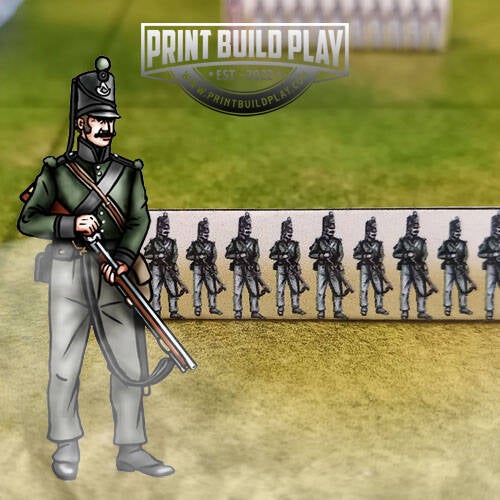
KGL Light
The KGL Light Infantry, or King's German Legion Light Infantry, was a formidable force used in the Battle of Waterloo. These troops were a highly trained, experienced, and organized infantry unit and were composed of German and Dutch soldiers from the former Kingdom of Hanover. The KGL Light Infantry was a part of the British Army and was instrumental in securing the victory for the allied forces at the Battle of Waterloo. The KGL Light Infantry was an elite unit, and their tactics and training reflected this. They were trained in light infantry tactics that enabled them to move quickly and with precision. They would often use skirmishing tactics, utilizing their speed and agility to outmaneuver their opponents. They were also experts in using cover and concealment and could effectively use their surroundings to their advantage in order to gain a tactical edge. The KGL Light Infantry was also highly disciplined and able to respond to orders quickly and efficiently. This allowed them to execute complex maneuvers in the heat of battle and to stay focused on the task at hand. They were also excellent marksmen and could accurately fire at their targets even in the midst of chaos.
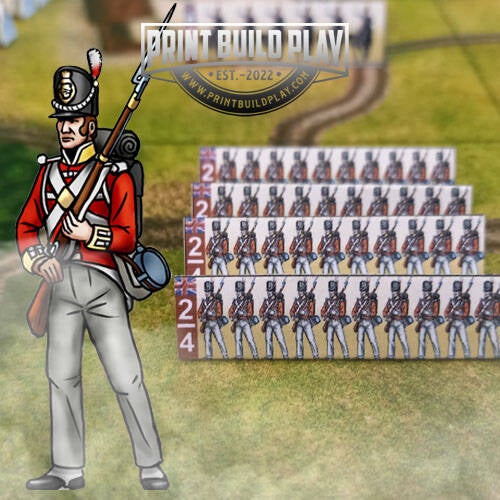
British line infantry
As one of the most powerful and important military units used in the Battle of Waterloo, the British line infantry were an essential part of the Duke of Wellington’s forces. The line infantry was composed of highly trained, disciplined and experienced soldiers who were able to carry out orders quickly, precisely and with a high degree
of efficiency. These soldiers were the backbone of the British army and their ability to maintain a disciplined formation in the face of enemy fire was the key to their success in battle. The British line infantry was most effective when used to form a line of battle. This allowed the infantry to provide a dense, unbroken wall of fire against the advancing enemy. This line could also be used to direct fire from other units, such as artillery and cavalry, against the enemy. The line infantry could also be used to form a defensive formation, allowing for the other units to counterattack or launch a surprise attack. The British line infantry was a highly effective force in the Battle of
Waterloo and helped the Duke of Wellington secure victory. The infantry’s skill at forming disciplined lines and directing fire allowed the British forces to maintain a
steady and effective line of defense against the enemy

KGL militia
The KGL militia was a key military unit used by the allied armies during the Battle of Waterloo. It was a light infantry unit made up of soldiers from the former Kingdom of
Hanover. The unit was known for its tenacity and skill in combat. It was especially renowned for its light infantry tactics, which allowed it to skirmish in small groups and quickly outmaneuver larger formations. At the Battle of Waterloo, the KGL militia was instrumental in helping the allied armies achieve victory. Their light infantry tactics allowed them to pick off enemy units from afar, making them a deadly force on the battlefield. They were often used to draw fire away from the main allied lines or launch surprise attacks on strategic points. The KGL militia was also known for their courage and determination. Despite being outnumbered and outgunned, they held their ground and fought valiantly. Their bravery and skill contributed greatly to the allied victory at Waterloo. Overall, the KGL militia was an invaluable asset to the allied armies during the Battle of Waterloo. Their light infantry tactics proved to
be a decisive factor in the victory, and their courage and determination in the face of adversity was an inspiration to all.

KGL infantry
The KGL Infantry, or King's German Legion, were a unit of the allied armies during the Battle of Waterloo in 1815. Formed in 1803 to serve the British army, the KGL Infantry
was composed of Hanoverian, Hessian, and Brunswick soldiers. The KGL Infantry was deeply involved in the Allied victory at the Battle of Waterloo, playing a significant
role in the allied victory. During the battle, the KGL Infantry was placed in the center of the Allied line, and they fought bravely and tenaciously to help the Allies win the day. The KGL Infantry also served as a reserve force, providing crucial reinforcements and support to the Allied line at crucial moments throughout the battle. The KGL Infantry proved themselves to be a dependable and reliable force, winning the admiration of many of their British allies. After the victory, the KGL Infantry received great praise for their courage and commitment in the face of the enemy. The KGL Infantry was a key component of the Allied forces at Waterloo, and their bravery and dedication was a major factor in the Allied victory.

British Foot guards
The British Foot Guards played an integral role in the Allied armies during the Battle of Waterloo. Comprised of the Grenadier, Coldstream, Scots, and Irish Foot Guards,
this elite military unit was used to spearhead assaults and defend key positions. Their experience and reputation for bravery made them invaluable on the battlefield. The
British Foot Guards were well trained and well disciplined, making them an ideal choice for the Allied commanders at Waterloo. The Grenadier and Coldstream Guards were the largest and most experienced regiments and were usually used in the vanguard of assaults, leading the charge and taking the brunt of the enemy fire. The Scots and Irish Guards provided additional support and were often sent to defend key locations. At Waterloo, the British Foot Guards played a key role in the Allied victory. The Grenadier and Coldstream Guards led several successful assaults, pushing back Napoleon's forces and ultimately securing the Allied victory. The Scots and Irish Guards provided additional strength and helped to hold off the enemy's counterattacks. The British Foot Guards fought bravely and heroically at Waterloo, helping to secure an Allied victory. Their skill and experience made them invaluable to the Allied forces, and their courage and determination were a testament to their courage and loyalty.

Highland Black Watch
The Highland Black Watch was a military unit that was used in the allied armies during the Battle of Waterloo. This unit was made up of Scottish soldiers who were
among the best trained and most experienced infantry in Europe. These men were known for their courage, toughness and willingness to take orders. The Highland
Black Watch was a key component in the allied forces during the Battle of Waterloo. They were used in the center of the front line and were tasked with defending the
army from the French onslaught. The Black Watch was able to hold off the French attack and even counterattack in certain areas. They were able to hold off the French for two days and were ultimately successful in pushing them back. The bravery and courage of the Highland Black Watch was a major factor in the allied victory at the Battle of Waterloo. They were a highly trained and experienced unit that was able to stand up to the French forces and ultimately win the battle.
The cavalry

KGL Hussars
The KGL Hussars were a light cavalry regiment in the British Army of the Napoleonic era. They were part of the King's German Legion, a military unit composed of
German and Dutch soldiers who fought for the British during the Napoleonic Wars. During the battle of Waterloo, the KGL Hussars were the only light cavalry regiment in the Allied armies. The KGL Hussars played an important role in the battle, providing an important reconnaissance capability for the Allied armies. During the battle, they were used to screen the Allied line from French cavalry attacks and to help gather intelligence on enemy movements. They also provided a mobile reserve that could be used to take advantage of opportunities or to respond to threats on the battlefield. The KGL Hussars proved to be an invaluable asset to the Allied armies
during the battle of Waterloo, and their contribution to the Allied victory was significant.

British light dragoons
The British light dragoons were an integral part of the Allied armies during the Battle of Waterloo. These horsemen were highly mobile and effective in combat,
providing the Allied forces with a great advantage. They were able to move quickly and carry out surprise attacks, which allowed them to outmaneuver the enemy forces. The British light dragoons were also able to utilize their speed to prevent the enemy from forming a cohesive line, which in turn prevented them from forming a strong defense. This allowed the Allied forces to gain ground quickly and take control of the battlefield. Additionally, the light dragoons were able to use their superior
maneuverability to launch surprise attacks on enemy encampments and reduce their numbers with ease. The British light dragoons were also effective in providing
reconnaissance and intelligence to the Allied forces. These horsemen were able to gain valuable information such as the location of enemy troops and supplies, which
allowed the Allies to plan their strategies accordingly. Overall, the British light dragoons were an invaluable asset to the Allied forces during the Battle of Waterloo.
Their superior speed and maneuverability gave them the edge they needed to gain the upper hand against the enemy
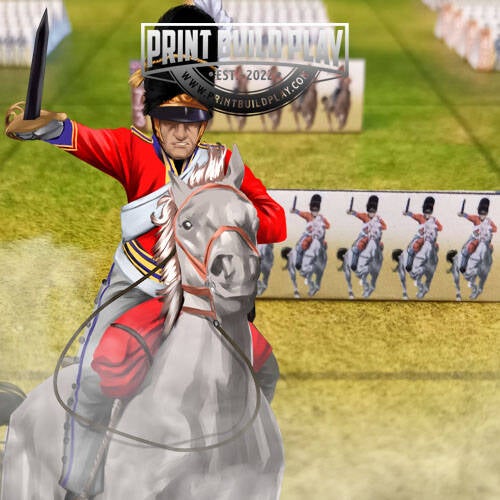
Scot Greys
The Scot Greys were a notable and renowned cavalry regiment of the British army, known for their brave and valiant actions during the Battle of Waterloo. The Greys
were the only regiment in the British army to have the privilege of wearing a uniform of grey, earning them the title of ‘Greycoats’. At Waterloo, the Greys were part of the
Allied Forces, under the command of the Duke of Wellington. The Greys were an important part of the Allied Forces’ victory, charging in and out of battle many times
during the course of the day. Their efforts were crucial in driving back the French cavalry, who were unable to stand up to the ferocity of the Greys’ charges. The Greys were also instrumental in helping to turn the tide of the battle, as they were able to outflank and outmaneuver the French army in order to gain the upper hand. The Scot Greys are remembered fondly for their heroics in the Battle of Waterloo, with many historians citing their actions as pivotal in the Allied Forces’ victory. Without the courage and tenacity of the Greys, the Battle of Waterloo may have had a very different outcome.
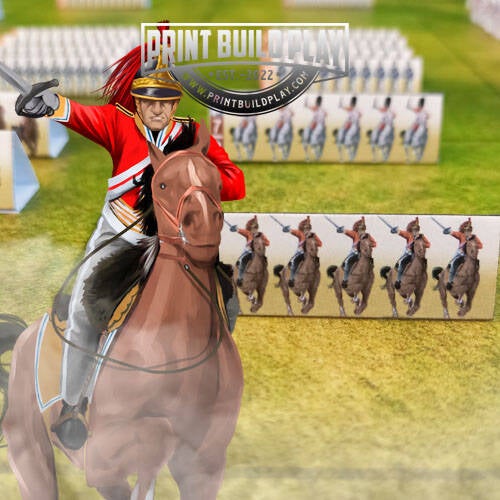
Inniskilling Dragoons
The Inniskilling Dragoons were a regiment of the British Army that fought in the Battle of Waterloo. They were founded in 1689 and had a long and distinguished history. The Dragoons were an elite cavalry unit, renowned for their courage and skill in battle. At the Battle of Waterloo, the Dragoons were part of the Allied forces under the command of the Duke of Wellington. They were positioned in the centre of the Allied line, along with Dutch and Belgian cavalry. The Dragoons played a pivotal role in the battle, especially in the hard-fought cavalry charges against the French. They were part of the cavalry reserve that charged the French centre, a move which ultimately broke the French lines and resulted in the Allied victory. The Inniskilling Dragoons made a significant contribution to the victory at Waterloo and their bravery and skill was commended by Wellington himself. They were later awarded a special battle honour for their actions in the battle, a testament to the courage and dedication of the regiment.

Horse Guards
The Horse Guards were a cavalry regiment that was part of the British Army in the 19th century. During the Battle of Waterloo, they were part of the Allied forces and played a crucial role in the victory. The Horse Guards were renowned for their bravery and skill, and they were instrumental in keeping the French forces at bay. They were able to charge into battle with great speed and ferocity, while also providing support to the infantry. They were also able to scout the terrain and provide valuable intelligence to the Allied commanders. The Horse Guards were a formidable force and their bravery and skill made them a key part of the Allied victory at Waterloo.

Life Guards
The Life Guards was a military unit of the British Army, and it played a pivotal role in the decisive Battle of Waterloo. On the 18th of June 1815, the Life Guards
deployed with the Allied forces, led by the Duke of Wellington, to face the French army led by Napoleon. The Life Guards were highly trained and professional soldiers,
and their expertise was critical to the success of the Allied forces. The Life Guards were ordered to the front line and charged with the task of defending against the French cavalry. The Life Guards were able to hold their lines and successfully repel the French advance. The Life Guards also provided a vital diversionary tactic, allowing the Allied forces to flank the French, and ultimately win the battle. The bravery and skill of the Life Guards was recognized, and their importance in the victory at Waterloo was undeniable. Their courage and commitment to excellence was essential to the Allied victory, and will always be remembered.
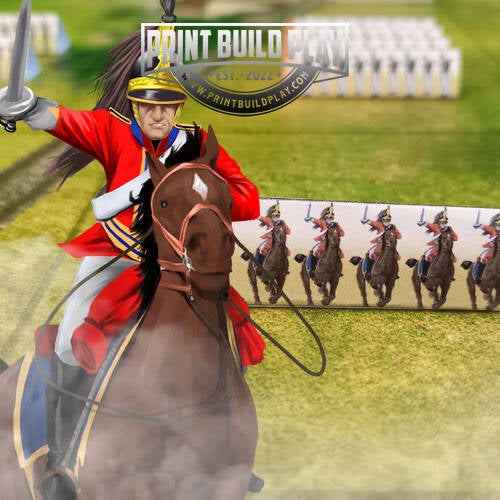
King's Dragoon Guards
The King's Dragoon Guards were a military unit of the British Army, formed in 1685 by the union of two troops of horse. They made their mark in the Battle of Waterloo in 1815, when they formed part of the Allied forces. The unit saw action on the right flank of the Allied line, where they faced a fierce attack from French cavalry. The Dragoon Guards managed to hold their position, allowing the Allied forces to counter-attack and eventually break through the French line. The Dragoon Guards were also instrumental in the pursuit of the retreating French army, eventually
leading to their defeat. The King's Dragoon Guards were a highly experienced and disciplined unit, and their bravery in the Battle of Waterloo was instrumental in the Allied victory. They were praised for their courage and dedication, and are still remembered as one of the most important units in the Allied forces.
The artillery

British field artillery
The British field artillery played an important role in the Battle of Waterloo. Composed of horses and cannons, the field artillery provided the Allied forces with the necessary firepower to make a stand against the French forces. The cannons were effective in taking out large numbers of enemy troops and were able to fire with accuracy over long distances. The horses were used to move the cannons quickly, allowing them to reposition when needed. This gave the Allied forces the mobility they needed to stay in the battle and keep up their defensive line. This proved invaluable as the French forces continued their onslaught. The British field artillery was an integral part of the Allied forces' victory at Waterloo. By utilizing their cannons and horses, they managed to stop the French forces from advancing and ultimately won the battle.

